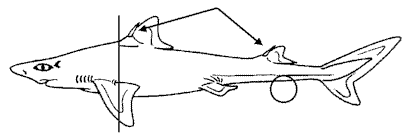Dogfish or Catshark?
Dogfishes and catsharks can be difficult to differentiate. Both are typically
smallish (1 to 4 feet or 30 to 120 centimetres), bottom-associated elasmobranchs
sharing a similar 'sharky' shape and some of the most familiar forms occur
together in coastal habitats. Adding to the confusion, some catsharks
(especially those of the genus Scyliorhinus) are often referred to as
"dogfishes". But once one has learned their respective field marks, it
is relatively easy to distinguish dogfishes from catsharks.
-
 lack an anal fin lack an anal fin
- the first dorsal fin originates well in front of the pelvic fins
- most have a sharp spine along the leading edge of each dorsal
- are generally stockier than catsharks
|
-
 have an anal fin have an anal fin
- the first dorsal fin originates over or behind the pelvic fins
- do not have spines on their dorsal fins
- are generally more slender than dogfishes
|
In addition, dogfishes are generally rather drab creatures (gray above, paler
below) but many catsharks are boldly and attractively patterned (the back may be
marked with any combination of stripes, bars, blotches, and spots — often in
various shades of brown, orange, or yellow). But since color and pattern can
vary greatly among individuals, physical features such as those listed in
point-form above are generally more reliable for distinguishing dogfishes from catsharks.
 lack an anal fin
lack an anal fin have an anal fin
have an anal fin